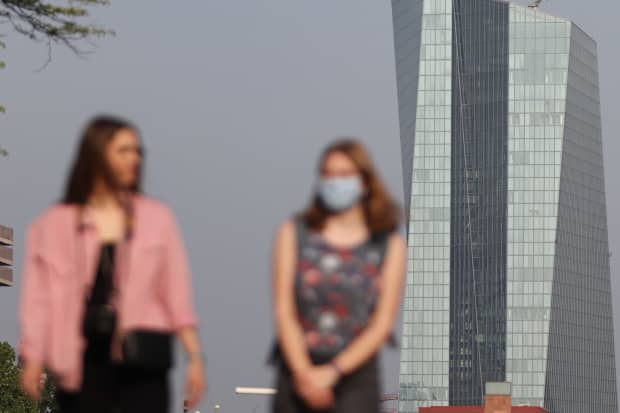This post was originally published on this site

Two young women, one of whom is wearing a face mask, walk in Frankfurt am Main, Germany, as the European Central Bank headquarters can be seen in the background, amid the COVID-19 pandemic on April 24, 2020.
yann schreiber/Agence France-Presse/Getty Images
It isn’t easy to make sense of purchasing managers indexes, with many harboring suspicion that these executives aren’t answering questions properly.
What the managers are supposed to do is report whether activity is better, or worse, than the previous month, but there are economists who say that, in practice, managers are reporting whether conditions are better or worse than usual.
“Many respondents to the survey may be reporting the state of output and the inflow of orders relative to more normal times rather than really answering the question whether the current month is better or worse than the previous one,” said Kallum Pickering, an economist at Berenberg Bank, in a note to clients.
So with that in mind, it is worth noting the latest forecast from ABN Amro, which is a pessimistic one. The Dutch bank says that, after the nearly stagnant level of eurozone composite PMI data in September, the eurozone economy may contract as early as the fourth quarter.
“We expect that domestic demand in the eurozone will contract in the coming quarters on the back of a sharp deterioration of the labor market and corporate retrenchment. The details of the PMI report also underlines this view, with the employment component of the composite PMI (47.5 in September) remaining at levels consistent with ongoing declines in employment,” said Aline Schuiling, an economist at ABN Amro.
Unlike the U.S., the eurozone unemployment rate hasn’t spiked, thanks to a variety of furlough measures in place. The unemployment rate was 7.9% in July, which is higher than the 7.2% rate when the region began locking down in March, but nowhere near the experience of the U.S., where the jobless rate spiked as high as 14.7% from 3.5% in March. The U.S. unemployment rate has subsequently declined to 8.4% in August.
The European Central Bank’s staff also expects the eurozone unemployment rate to rise. Earlier in the month, the central bank said the jobless rate in the region will rise to 9.5% next year, and that is using fairly benign assumptions. “This assumes that the job retention policies are largely successful in keeping short-time workers in employment, with a limited transition into unemployment for those exiting from job retention schemes,” the ECB said.
The ECB allowed that in what it called a “severe” scenario, the unemployment rate could rise as high as 11.4%.
Economists at Barclays also expect the unemployment rate in the euro area to climb, though they still see the economy continuing to expand in the fourth quarter and into next year.
In a note published on Thursday, Barclays says the eurozone economy will grow 1% versus the third quarter, and the unemployment rate will peak at over 10% next year. Barclays says the “real rebound” won’t occur until the second half of next year, by which time vaccines will have arrived and the European Union recovery initiatives will have gained traction and boosted investment.

